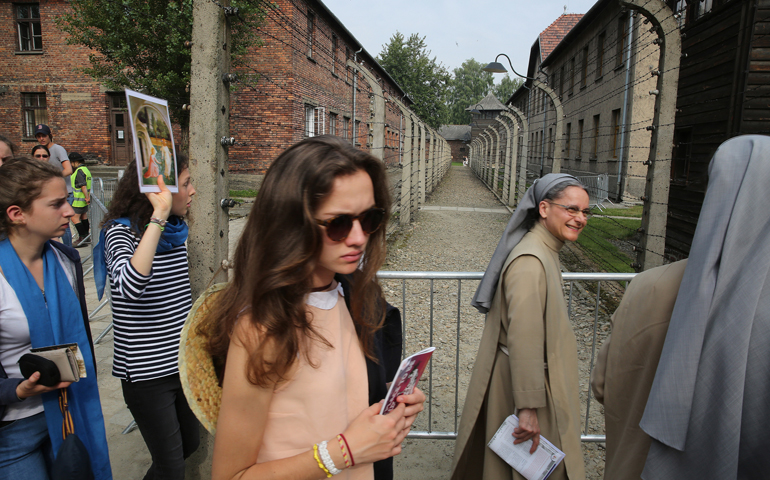
World Youth Day pilgrims walk past buildings during a July 25 visit to the Auschwitz former German Nazi concentration camp in Oswiecim, Poland. (CNS/Bob Roller)
Editor's note: Kristen Whitney Daniels, NCR's newest Bertelsen intern, is in Warsaw, Poland, for World Youth Day 2016; she will be blogging about her experience on NCRonline.org. Look for Kristen's posts at feature series page World Youth Day 2016.
Silence.
There was an eerie quietness that settled upon the thousands of pilgrims as they walked on the same gravel as the 1.3 million prisoners who were forced into Auschwitz-Birkenau, the Nazi concentration and extermination camp that opened in 1940.
The Auschwitz-Birkenau Memorial and Museum has exclusively opened its doors to World Youth Day pilgrims from July 20-28 and August 1-3. Hoping to bring this experience to pilgrims from around the globe, the Memorial and Museum staff are expecting hundreds of thousands of visitors during this time. On July 29, Pope Francis will be visiting the site, as have his two previous predecessors. He has invited former prisoners of these camps to meet with him at the site. He is expected to pray at the "wall of death" located at Block 11, as well as at St. Maximilian Kolbe's cell.
Pilgrims were taken through a very specific route through both camps. At Auschwitz, pilgrims paused and prayed in front of Block 11, the block where St. Maximilian Kolbe was forced into a starvation cell after he offered his life in place of fellow prisoner Franciszek Gajowniczek. The last remaining prisoner from his group after 12 days of starvation, Kolbe was killed by lethal injection. Gajowniczek was reunited with his wife following the liberation of the camp.
It is impossible to accurately describe how it felt to be walking on the dirt and gravel where so much blood was shed and people's ashes were carelessly discarded. Where human life lost its inherent dignity. Words fail me. Because when you truly look at the Holocaust and these concentration camps, you remember that humans were the ones who created them. My fellow human beings were the ones who killed 1.1 million people, 90 percent of them Jewish, in Auschwitz-Birkenau alone.
There was one moment that stood out vividly to me and many of my fellow pilgrims. After Auschwitz, buses transported us to the Birkenau camp, which was easily 10 times the size of the other camp. We entered alongside the train tracks, the same ones that transported the majority of the men, women and children who entered to their deaths. We walked along the gravel and dirt trapped on both sides by barbed wire and watch towers. About 3 kilometers into the walk we passed a nondescript building, described as the processing center where prisoners were stripped of their names, clothes and dignity. Passing along, we finally experienced some shade. Set in this pocket of shade were large, blown-up photos of prisoners standing, sitting and waiting in the same trees we were now resting in. While the photos were haunting, it was the caption that put everything into context. It stated that this area was where prisoners awaited their immediate death in the gas chambers after their arrival, often waiting hours in these woods, passing the time.
This very space we occupied, the very trees that surrounded us and kept us safe from the sun's harsh rays, were the same trees that felt so many people's last breaths.
It was an emotional day. One that I am still trying to unpack in both my mind and heart. Following Auschwitz-Birkenau, we arrived at the Shrine of Divine Mercy, where St. Faustina received her vision of mercy -- prior to the start of the Holocaust -- an idea that so desperately needed to be embraced by the people of that time. However, it would be a mistake to assume that mercy was something only needed by those in the past. In this Year of Mercy, at the World Youth Day whose theme is "blessed are the merciful for they shall obtain mercy," it seems to be a word that is begging for our attention.
Cardinal Sean O'Malley of Boston celebrated a mass for English-speaking pilgrims at the Sanctuary of Divine Mercy, located at the Shrine. During his homily, O'Malley spoke of the Holocaust's significance today. He said, "Indifference makes suffering possible. … The antidote to all of this is mercy."
Our trip to Auschwitz-Birkenau requires remembrance, preservation and prevention. After studying the Holocaust so much in school, it can often seem more of a repetitive fact than an actual period of time where unspeakable horrors occurred. Many people are desensitized to this pain. It may be the reason why similar atrocities occur today. As one sign at Birkenau stated, "Indifference kills." Our responsibility is to carry this pain with us and to ultimately choose mercy.
*This story has been updated to clarify captions.
[Kristen Whitney Daniels is an NCR Bertelsen intern. Her email address is kdaniels@ncronline.org.]



